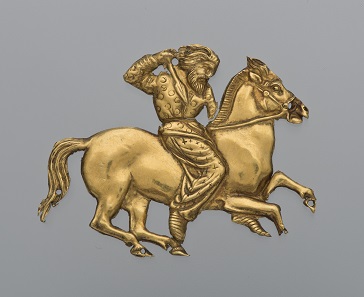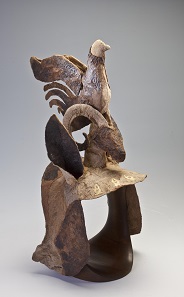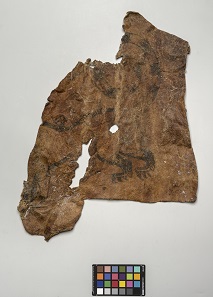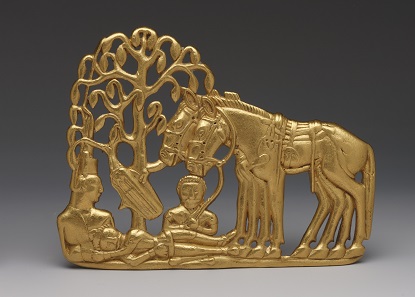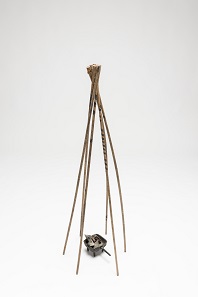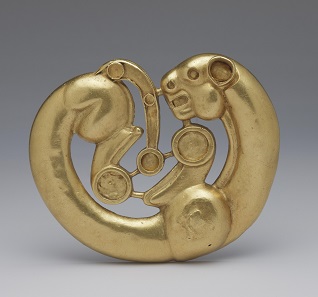September 14, 2017 – At the British Museum in autumn 2017, it is possible to discover an ancient culture that was buried in the Siberian permafrost for thousands of years. The BP exhibition “Scythians: warriors of ancient Siberia” will reveal the history of these powerful nomadic tribes who thrived in a vast landscape stretching from southern Russia to China and the northern Black Sea.
A gold plaque depicting a Scythian rider with a spear in his right hand. Gold; second half of the 4th century BC, Kul’ Oba. © The State Hermitage Museum, St Petersburg, 2017. Photo: V Terebenin.
The Scythians were exceptional horsemen and warriors, and feared adversaries and neighbours of the ancient Greeks, Assyrians and Persians between 900 and 200 BC. This exhibition tells their story through exciting archaeological discoveries and perfectly preserved objects frozen in time.
This is the first major exhibition to explore the Scythians in the UK in 40 years. Many of the objects on display date back over 2,500 years. They are exceptionally well preserved as they come from burial mounds in the high Altai mountains of southern Siberia, where the frozen ground prevented them from deteriorating.
Horse headdress made of felt, leather and wood. Pazyryk 2, late 4th – early 3rd century BC. © The State Hermitage Museum, St Petersburg, 2017. Photo: V Terebenin.
Over 200 outstanding objects will reveal all aspects of Scythian life, including a major loan in collaboration with the State Hermitage Museum, St Petersburg, and other generous loans from the National Museum of the Republic of Kazakhstan, the Ashmolean Museum and the Royal Collection. Some are star pieces which are displayed in the permanent galleries and Treasury of the State Hermitage Museum and others have never been loaned to the UK before.
Part of human skin with a tattoo. From the left side of the breast and back of a man. Pazyryk 2, late 4th – early 3rd century BC. © The State Hermitage Museum, St Petersburg, 2017. Photo: V Terebenin.
Objects preserved by the permafrost include multi-coloured textiles, fur-lined garments and accessories, unique horse headgear and tattooed human remains. Tattooing was common among the Scythians and incredible examples were preserved in the frozen tombs. This art shows natural and mythical animals with heavily contorted bodies, often in close combat, and we have examples of exceptionally well-preserved early tattooed remains on loan from the State Hermitage Museum.
A gold belt plaque of a Scythian funerary scene. Gold; 4th – 3rd century BC. Siberian Collection of Peter the Great. © The State Hermitage Museum, St Petersburg, 2017. Photo: V Terebenin.
Life in the Siberian landscape was tough and there was heavy competition for survival. The Scythians developed a fearsome set of weapons: pointed battle-axes and short swords for close combat and powerful bows for long-distance archery. Painted wooden shields, armour and a helmet have survived from the ancient tombs. The Scythians were skilled horsemen and they took their beloved horses with them to the grave so that they could carry on in the afterlife. Favourite horses were specially adorned for this and wore elaborate costumes, with masks, saddle pendants and covers for the mane and tail, which were intended to transform them into mythical beasts.
Six sticks of a smoking tent frame and brazier. Pazyryk 2, late 4th – early 3rd century BC. © State Hermitage Museum, St Petersburg. Photo: V Terebenin.
This exhibition explores who the Scythians were, how they appeared, what they wore, who they traded with and what they ate and drank. Perfectly preserved seeds have been found in some tombs and were part of a Scythian ritual involving the deliberate inhalation of the smoke from charred hemp. The fifth century BC Greek historian Herodotus described how Scythians ‘howled with pleasure’ when they inhaled the smoke and how it was employed in cleansing rituals and for pain relief. A reconstruction in the exhibition shows an ancient brazier together with the hemp seeds and the felt hood which was put over the top like a miniature tent.
Gold plaque in the shape of a coiled panther. Gold; 4th – 3rd century BC. Siberian Collection of Peter the Great. © The State Hermitage Museum, St Petersburg, 2017. Photo: V Terebenin.
There are stunning pieces of gold jewellery, gold applique to adorn clothes, wooden drinking bowls, and a highly decorated leather bag even containing remarkably well-preserved lumps of cheese that are over 2,000 years old. There was a two-way between the culture of the Scythians and their settled ‘civilised’ neighbours. Many objects in this exhibition show evidence of cultural interaction, from Scythian wine-drinking learnt from the ancient Greeks and Persians, through ancient Greek craftsmen who depicted archers in Scythian dress, and the gold objects in the Achaemenid Oxus Treasure in the British Museum’s collection that are influenced by Scythian art.
Gold applique showing two archers back to back, Kul’ Oba, 400BC – 350BC © The Trustees of the British Museum.
In about the second century BC the Scythians disappeared and were replaced by other nomadic powers. The exhibition concludes with an exploration of what happened afterwards and takes a look at life in southern Siberia in the early centuries AD. These objects are also spectacularly well preserved, but through extreme dryness rather than extreme cold.
Haunting painted clay death masks decorated to resemble the tattooed faces of the deceased are shown alongside beautiful clothing and the reconstructed log-cabin tomb chamber in which they were discovered. The growing application of archaeological science is unlocking clues to the past, and new results from collaborative work by the British Museum and the State Hermitage Museum will be included in the exhibition. This exhibition will allow visitors to discover the life and legacy of the Scythians, revealing their history like never before.
Further information, including the public programme of events, can be obtained from the relevant British Museum website.
And much interesting on the Scythians can also be read on Livius.org.



